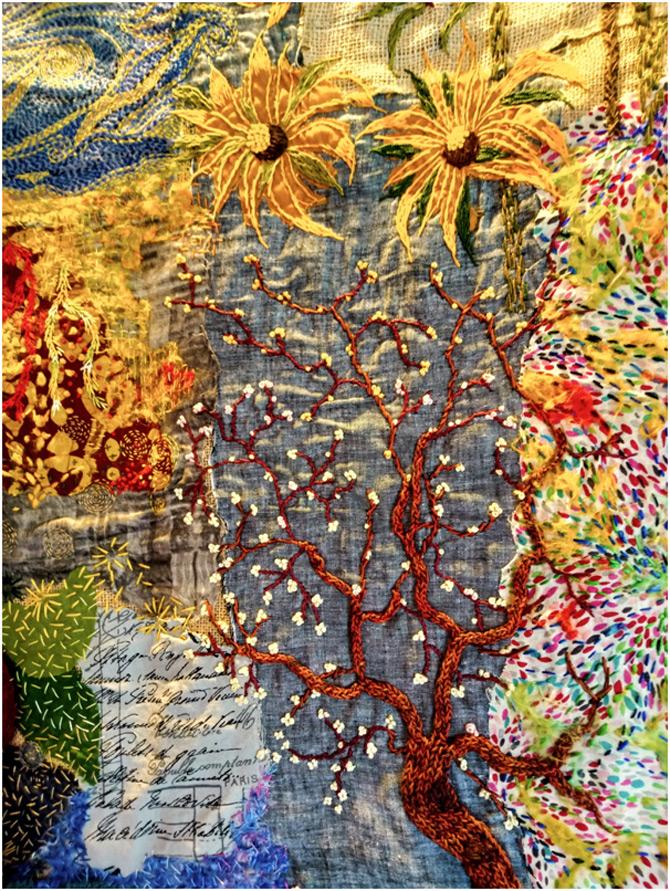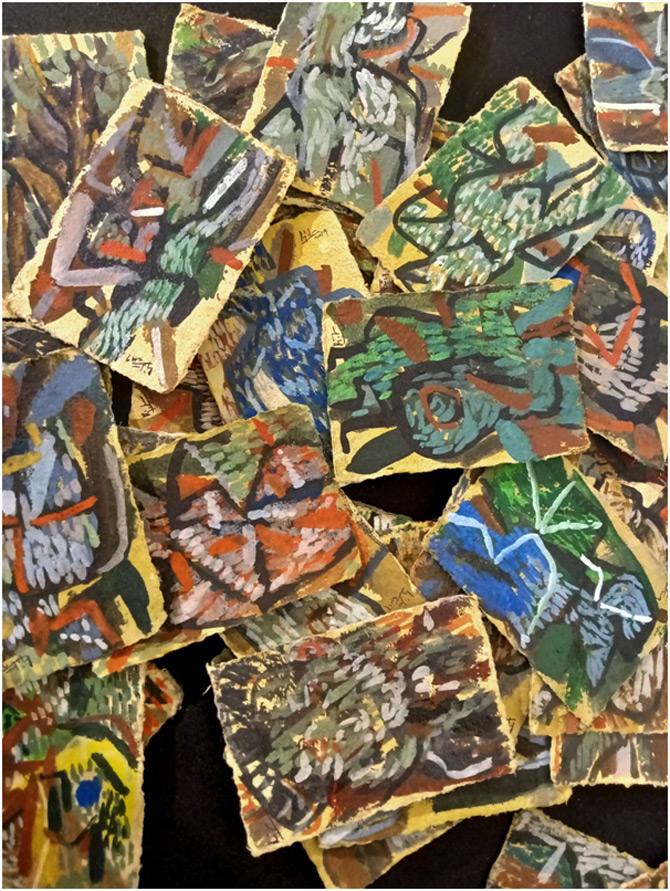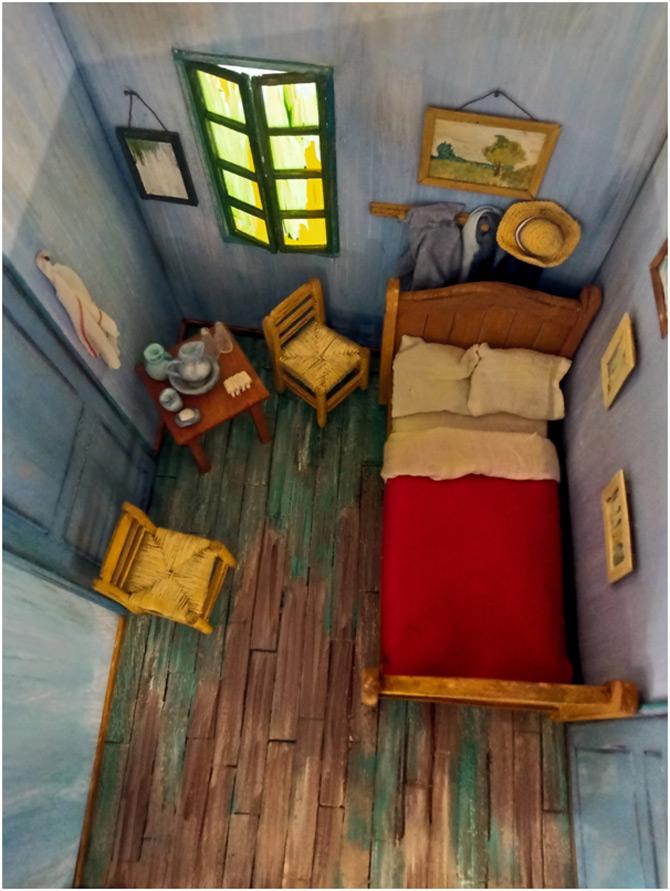Artists interpreted legendary Dutch artist's work using mixed media and installations at a recent event in Pune. The results are interesting, but the task is a daunting one

The exhibition was held at Poona Western Club, Bhugaon in Pune
Sushmita
A three-day event on various artists' interpretation of Dutch artist Vincent van Gogh's letters to his brother Theo concluded last Sunday in Pune. The event, organised by Art Lane, a Pune-based art group, showcased breathtaking pieces of art and performances, including sand art and a classical dance. Through his lifetime, Van Gogh wrote 651 letters to Theo. These letters have become the guiding light into how Gogh became an artist. Theo, apart from being Gogh's artistic adviser, was his confidant, discussing with him matters of love, life, family, other artists and more. Their correspondence is known to have marked a joint struggle for the 'art of the future'.
ADVERTISEMENT
 An artwork used a combination of cloth patchwork, sequined embroidery and Kantha stitch to bring to life some of Gogh’s most famous paintings’ motifs, the Sunflower, Starry Night, Moving Skies, and Almond Blossoms
An artwork used a combination of cloth patchwork, sequined embroidery and Kantha stitch to bring to life some of Gogh’s most famous paintings’ motifs, the Sunflower, Starry Night, Moving Skies, and Almond Blossoms
Held in the Poona Western Club, Bhugaon, the hall displayed several installations and mixed media works. One of the first works was a unique combination of cloth patchwork, sequined embroidery and Kantha stitch—a type of embroidery particularly popular in Bangladesh, West Bengal and Odisha—that brought to life some of Gogh's most famous paintings' motifs, the Sunflower, Starry Night, Moving Skies, and Almond Blossoms.
Artist Raju Sutar, one of the pioneers of modern art as it exists today, wrote to Van Gogh in multi-coloured postcards in bold colours, while Artlane Kalagoshthi's co-founder Smita Raje's installation allowed people to write to Van Gogh in picture-postcards made of the photographs she has clicked over years.
 Artlane Kalagoshthi’s co-founder Smita Raje's installation allowed people to write to Van Gogh in picture-postcards made of the photographs she has clicked over years
Artlane Kalagoshthi’s co-founder Smita Raje's installation allowed people to write to Van Gogh in picture-postcards made of the photographs she has clicked over years
Artist Zereh Lalji's miniature version of Van Gogh's bedroom based on his famous painting, Bedroom in Arles, took the onlookers' breath away with every small detail from the room in the painting, brought into 3D motion in tiny fragments of her piece.
A painting in Braille seemed like a good step towards inclusion, but it was unclear how a person with visual disability would perceive it or what it would have meant to them.
While most of the artworks did a fabulous job of bringing to life Van Gogh's use of bold and vibrant colours—the emerald greens and deep blues—his motifs, his techniques and the movement in his paintings, there seemed to be some lack of attempt at reinterpreting Van Gogh's essence of painting those paintings.
 Artist Raju Sutar wrote to Van Gogh in multi-coloured postcards in bold colours
Artist Raju Sutar wrote to Van Gogh in multi-coloured postcards in bold colours
Over the years, particularly since the time his letters to Theo became public, giving an insight into Van Gogh's mind, certain aspects of his life have become overly romanticised, like his mental condition. However, as artist Anil Awchat said in the opening talk of the exhibition, the point of a painting is to paint, which is what Van Gogh sought out to do every day of his adult life till the moment of his death. Closer to the day before he killed himself, he had averaged one painting a day. Awchat contrasted this with today's situation, in which art has become synonymous to exhibitionism.
Not art for art's sake
The works of Jean Francois Millet, Jules Breton and others gave birth to the "peasant genre" of the Realism movement that began in the 1840s. Millet had a significant influence on the works of Van Gogh. He described the works of Millet and Breton as having religious significance, "something on high". "Millet's paintings, with their unprecedented depictions of peasants and their labours, mark a turning point in 19th-century art. Before Millet, peasant figures were just one of many elements in picturesque or nostalgic scenes," notes the Van Gogh museum, located in Amsterdam.
In Millet's work, working men and women had taken the centre stage and became more real. Millet was the only major artist of the Barbizon School who was not interested in 'pure' landscape painting."
 Bedroom in Arles by Zereh Lalji
Bedroom in Arles by Zereh Lalji
This influence on Van Gogh's work too, can be seen, whether it was the modest supper at Nuenen, Netherlands depicted in his painting, Potato Eaters or the Peasant Character, in which he studied the daily life of the working people around him. "One must undertake with confidence, with a certain assurance that one is doing a reasonable thing, like the farmer who drives his plow... (one who) drags the harrow behind himself. If one hasn't a horse, one is one's own horse," Van Gogh had noted.
Van Gogh's own life had a deep resemblance or likeness to the ones he was trying to paint, he would labour hard in blazing sun or blowing winds for long hours, enduring frost and snow in winter, living moderately. Van Gogh's frustration with traditionalists, who were focused more on technique than on the people they were painting is apparent in his letter to Theo in the year 1885 in July from Nuenen. Van Gogh expresses his distaste for artists painting solely on the basis of "technique". "As far as I know, not a single academy exists in which one can learn to draw and paint a digger, a sower, a woman hanging a pot over the fire, or a seamstress," Van Gogh had said. In the same letter, Van Gogh pointed out that he didn't want his figures to be good, or academically correct, and calls Millet and Lhermitte as "true artists" because they didn't paint in a dry, analytical manner, but because they painted things as they felt them to be.
Any project that takes up the responsibility of re-interpreting Van Gogh's life has the moral responsibility of not evading what is evident in his paintings. It has the responsibility of, in John Berger's words not indulging into "mystification" of the work of the artist.
Sushmita is a researcher working on forest rights issues. She has keen interest in contemporary and modern arts. She can be reached out at @sushmitav1
Catch up on all the latest Mumbai news, crime news, current affairs, and also a complete guide on Mumbai from food to things to do and events across the city here. Also download the new mid-day Android and iOS apps to get latest updates
 Subscribe today by clicking the link and stay updated with the latest news!" Click here!
Subscribe today by clicking the link and stay updated with the latest news!" Click here!







